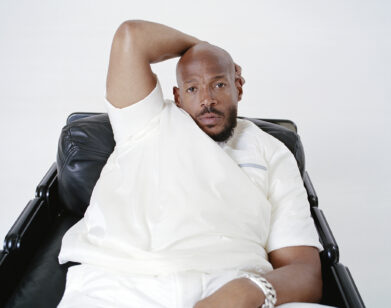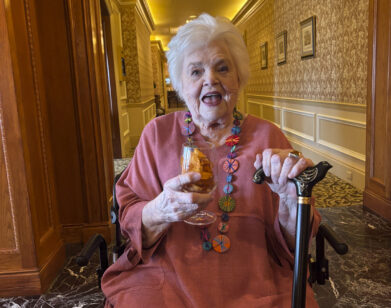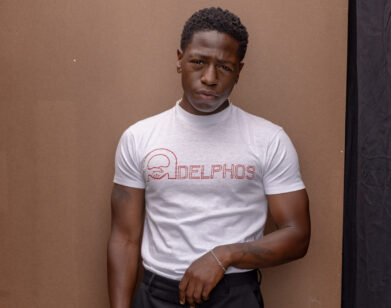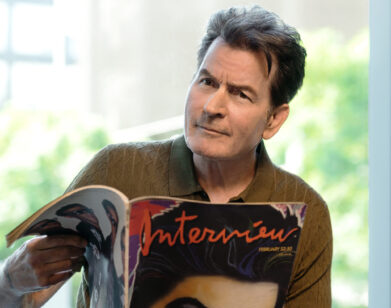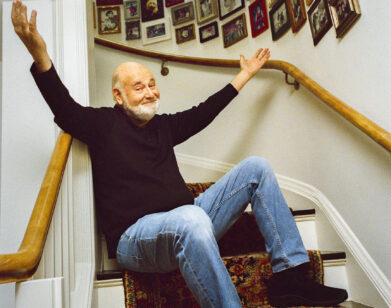David Lowery’s Deconstruction
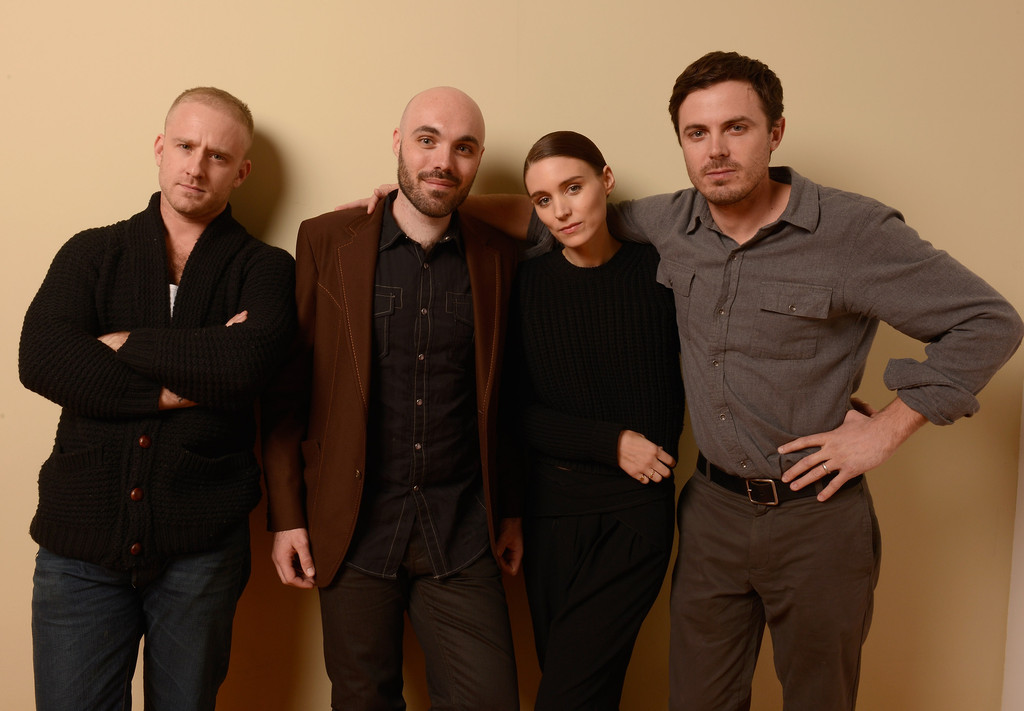
ABOVE: (LEFT TO RIGHT) BEN FOSTER, DAVID LOWERY, ROONEY MARA, AND CASEY AFFLECK AT SUNDANCE, JANUARY 2013.
A pregnancy, a robbery, a police chase, a shoot-out, multiple deaths, and life in prison—punctuated by percussion—the first 20 minutes of Ain’t Them Bodies Saints could be a film in and of itself.
Written and directed by David Lowery, the film is set in the 1970s. The decade, however, is irrelevant; all that matters is that it is a story of the past when the US was wild with outlaws. Casey Affleck and Rooney Mara play childhood sweethearts and partners in crime, Bob Muldoon and Ruth Guthrie. The supporting cast includes Ben Foster as a local cop Patrick Wheeler, Keith Carradine as Bob and Ruth’s father figure Skerritt, and Nate Parker as Bob’s friend Sweetie.
Comparisons to Badlands (1973) and Bonnie and Clyde (1967) are inevitable, but Ain’t Them Bodies Saints is much more than the sum of its predecessors. Like a short story, every shot in Lowery’s film is deliberate. His protagonists seldom share scenes, but when they do, it matters. It is not surprising that, when he is not writing films, Lowery works as a cinematographer and editor for films like Upstream Color. Shot on 35mm film, Lowery explains that he wanted the film to look like it was “shot through a burlap sack” or “an old piece of wood that you could reach out and touch it and feel the texture.”
EMMA BROWN: When you started writing Ain’t Them Bodies Saints, did you see it as a Western, an outlaw film, or a love story?
DAVID LOWERY: The very first idea was to write an action movie—I thought it would be fun. I find that very often those inciting ideas are great to get a project going, but they quickly evaporate. That was the case with this film. Very quickly, the action parts sort of fell away. I became really excited about the idea of doing—I hesitate to use the word “deconstruction”—but sort of a meditation on an outlaw movie. I wanted to make a film that dealt with the very familiar tropes of the outlaw movie and tweaked them in very specific ways. There was certainly an element of romance to it, but never really blossomed into a love story until we were shooting and we saw the chemistry that Casey and Rooney had together. It suddenly became much more a love story than it had ever been before.
BROWN: When did Casey and Rooney become involved? Did you have them in mind when you were writing the film?
LOWERY: No, they came fairly late in the game. I had written the script about a year before they read it. I just assumed that I would be making it the way I always make films, which is with my friends in Texas for very, very low budgets. That was the plan. Then the script got out; people started to read it. Casey and Rooney wanted to do it. I met with them and six months later we were shooting. I was asked what actors would I want in the movie if I had my choice, and they were both at the top, along with Ben Foster.
BROWN: The rhythm at the beginning of the film is incredible; did you have that pace in mind when you were writing it?
LOWERY: Yeah, that was on the page. My idea with the whole film was to put as much information as possible in the first 15, 20 minutes of the movie—have the pace be as quick and as fleeting as possible—and then just have everything stop dead, for better or worse. I wanted an incredible, rhythmic and percussive and fluid opening sequence, but then the breaks would hit and everything would slow down and spread out—every beat would be distended. We worked on [the beginning] a great deal. We cut it, shot some more, cut some more, showed it at Sundance, and cut even more after that. It was something very specific that I was trying to achieve. I could keep editing it even now, that sequence. I’m very proud of it and it’s something that I could keep working on forever.
BROWN: Were the first 15 minutes the hardest to write?
LOWERY: No. I find the beginnings are always very easy because it’s easy to think of something that would be interesting to look at. I want to start off a movie in a way that would grab the audience like a script would grab the reader. You also want to convey certain information and hold back other information. You just keep writing and cutting yourself off, and writing and cutting yourself off. One of my favorite rules of writing: stop whenever it’s feeling really good, so you have something to look forward to the next day. I was doing that in a macro sort of way, where you’re writing a lot of different scenes and a lot of different material and every time it starts to get good, you cut away to something else. I really enjoy that sort of narrative structure—that kind of storytelling—moving from one thing to the next and trying to build an accumulative sense of a story rather than the traditional plot beats. It’s almost like narrative découpage: you’re putting a lot of little pieces in there—a lot of them have a very practical narrative value and others are more about feeling or tone and you’re pushing them all into this one tight knit, narrow space and trying to get them to flow. It’s very fun. That was probably the easiest to write, to be honest.
BROWN: What was the most difficult part to write and realize?
LOWERY: The most difficult was defining the relationships afterwards, because, like I said before, I really wanted to movie to slow down and for not that much to happen afterwards. There’s not a ton of plot. I was trying to get very precise and very delicate emotional content to come across over a very sparse narrative structure. When you have very little happening, every little beat counts. Trying to find the right little pieces, the right little lines of dialogue and the right little moments between characters that would carry enough significance to justify the pace of the movie at that point. Especially between Ben Foster’s character and Rooney’s character. They only have three scenes together in the film and trying to figure out what happened in each one of those scenes so you could feel the arc of their narrative reach an appropriate climax—that was really, really difficult, and that continued through the entire shooting process. We were constantly on set, especially with those scenes, trying to rewrite them and figure out what information exactly needed to be there. It was a constant dance of how much is enough—how little can we get away with—and what are these characters truly feeling in these moments, because it’s so delicate.
BROWN: One of my favorite moments is when Skerritt mistakes Patrick Wheeler, who is Ben Foster’s character, for Casey’s character Bob, and apologizes to him. It explains Skerritt and Bob’s relationship and opens this history between the two of them.
LOWERY: It does, that was another thing that was tricky, was saving so much backstory for later in the movie. I felt that by the time you get to the last five minutes of the movie, you will have enough pieces to sort of reverse engineer what the character’s relationships were and what their history together was. It certainly was a risk, waiting for the last second to deliver crucial information like that.
BROWN: Bob and Ruth have a very intense, intimate connection, but they aren’t often on screen together. Did you have your actors live together before you started filming to achieve that intimacy?
LOWERY: We unfortunately didn’t have time to do any rehearsals beforehand, but we did manage to find a place to film on the border between Texas and Louisiana that was so remote that we were able to sort of build a really tight family unit. That being said, we shot the movie in a bifurcated fashion: Casey shot all of his material first, and then Rooney shot all of her material. They had three days where they overlapped. It wasn’t until the first day we had the two of them together—when we were halfway through the entire production—that we realized how strong their chemistry was. That was entirely them. I wrote it as well as I could, and I tried to write a context in which they could feel comfortable together. The first thing we shot with them was when they are in the truck before the robbery. We just let the cameras roll, and let them do the script and let them take things further than the script and watched that chemistry instantly start to grow and turn into something more profoundly moving than anyone expected it to be. That was originally the opening scene of the film, and when we saw how wonderful they were together, we realized there needed to be more. That was something we lucked into; it could have gone the other way, but I was just delighted at how well they took to each other.
BROWN: You mentioned that you wanted to create something that looked antiquated, but in modern way. How do you see the outlaw film fit into modern cinema? It’s such an iconic genre, but there haven’t been very many great, recent attempts.
LOWERY: I didn’t really think about it too much in these contexts until we showed the movie at Cannes, and all of a sudden, showing a movie that felt very American in France re-contextualized it in an interesting way. I had always looked at it in terms of film history, drawing on Bonnie and Clyde, Badlands, Gun Crazy (1950), and Thieves Like Us (1974)—even Natural Born Killers (1994) and True Romance (1993). The film is referencing all of those, it’s referencing that whole history, but once we start talking about it in a grander context, I was thinking about how American that whole ideology is and how, as a nation, America has always romanticized outlaws. The whole country sort of rooted in a state of rebellion—that is very appealing to Americans on a cultural level, and it has been ever since the days when Jesse James and Billy the Kid were idolized despite their horrible misdeeds. It continues now when you see kids who have Scarface posters hanging up in their room. The idea of an individual making their own way—taking what they want and doing it on their own terms—is undeniably appealing. It’s easy to focus on those things and not on the bloodshed, the crimes, and the ill will that got them there. Everyone always ignores the fact that these characters always go out, not in a blaze of glory, [but] in a pretty sad and un-heroic fashion. That is part of what Bob Muldoon is realizing, he fancied himself an outlaw in that tradition, but he is realizing that his idealism is not going to carry him through.
BROWN: But do you think the failure of the outlaw is as much part of the American idealization of the outlaw as the idea of the outlaw itself?
LOWERY: I am not enough of a historian to say for sure, but my gut reaction to that question is that it’s not part of it yet. I think that people still idolize it and still model themselves after it without even realizing it. There hasn’t been enough failure to make that part of the whole mythology as well.
BROWN: What is your next film going to be?
LOWERY: There are a couple of things that I am working on, and I don’t know which will happen first. I am writing more than I have ever before because suddenly, with this film, I have got the luxury of people believing that I can actually make a movie now. It has enabled me, or at least encouraged me, to try to have another film ready to go quickly. I have this one project based on a New Yorker article that I am writing right now. Robert Redford is supposed to star and produce it, and hopefully that will happen.
BROWN: Would it make you nervous to direct an actor who also directs himself?
LOWERY: I thought about it. I thought about it for, like, five seconds and realized that would be a disastrous path to go down mentally. So I am just not even thinking about it. I am just trying to write a really good script, and one that conveys what I want clearly enough.
AIN’T THEM BODIES SAINTS COMES OUT IN LIMITED RELEASE FRIDAY, AUGUST 16.

